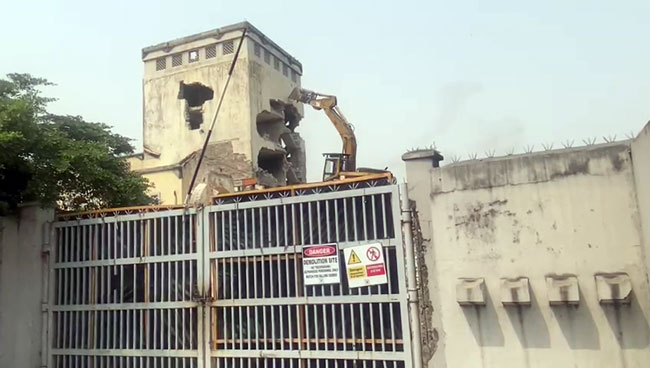
The Igbosere High Court has yet to be rebuilt two years and five months after it was torched during October 20, 2020, #EndSARS protest against police brutality. Onozure Dania writes
On December 12, 2022, Lagos State governor, Mr Babajide Sanwo-Olu, commissioned the reconstruction of the state High Court, Igbosere, burnt in the wake of the violence was burnt in the wake of the violence arising from the October 20, 2020, #EndSARS protests, especially in states in the southern part of the country. It’s been two years and five months after the incident.
The Igbosere Court, one of the torched facilities, dates back to the period when Lagos became the British Protectorate. It was formerly known as the Supreme Court until the relocation of the Federal Capital Territory to Abuja when the court reverted to a state High Court.
Iconic court
The iconic colonial vestige doesn’t look like it would be ready soon four months after the governor’s flag off the place still looks desolate.
Car owners have converted the court’s back gate where the Statue of Justice is when one enters the court through Igbosere Road as a car park. Also, the back gate of the magistrates’ court has been turned to a sleeping abode with dirt all over the place and an offensive smell of urine.
The burnt courts made the dispensing of cases difficult as it took a long while before judges and magistrates started sittings by sharing courtrooms with cases scattered in different courts in the state.
The reconstruction of phase one of the courts was expected to cost about N9bn and is estimated to be completed within 18 months. Our correspondent who visited the court premises observed that the contractors were still on the foundation level of the reconstruction.
During the flag-off of the reconstruction, Sanwo-Olu decried that the edifice built during the colonial era was destroyed during a needless protest.
He said “This is a significant event that we cannot gloss over, and not let history be put in proper perspective, and put the record straight. Igbosere High Court is not just a historic edifice, but it was and will come back to be the oldest facility that continues to discharge justice in our country, and in the state of Lagos.
“It was an edifice that existed before any of us here today, but we all remember the event that happened about two years and two months ago. The needles protest that befell our city on nothing that we knew nothing about, nothing that we caused, nothing that was generated by us brought us down.
“It is part of our history, but as a resilient people, no matter how many times we fall down, we would rise up and come back bigger and better. The reconstruction of Igbosere High Court is life, and direct and we will all be alive to see its completion.”
The governor added that he was at the Igbosere premises a month before it was burnt by hoodlums, thinking of how to renovate and expand the edifice, not knowing that it would be burnt down.
“We have assembled a well-thought-out team. This is a team that we took out of government, because we do not want the bureaucracy of government to becloud it, led by Dr. Yemi Cardoso, to lead private and public sector professionals that have distinguished themselves in their chosen careers to advise the government on the rebuilding exercise.”
Sanwo-Olu explained that the new courthouse would give judges and judicial officers ample space to work while maintaining the independence of the judiciary.
He said: “We are here to let people know that we have put the emotions behind us. We are forward-looking people. This event further confirms the strong spirit of Lagos and the resilience of the city, which explains our ability to withstand shocks and build back better.
“We will never allow the forces that razed the building to win the battle. That is why we are publicising the reconstruction of the Igbosere Court to let the whole world know and show our resilience. We will be turning this bad situation into a positive development.”
Also, the Chief Judge of Lagos State, Justice Kazeem Alogba, who was at the event recalled that on the Sunday preceding the 2020 Legal Year ceremony, he and some Judges inspected the Igbosere High Court complex to wrap up preparations, and observed that the foyer would no longer be suitable for the legal events and should be extended.
Justice Alogba said throughout the burning of the high court complex the Statue of Justice and the two statues of lions in front of the court were not affected.
On his part, state Attorney General and Commissioner for Justice, Mr Moyosore Onigbanjo, SAN, said the October 2020 incident would continue to be remembered as a sad day in the history of the Nigerian judiciary.
The Chief Press Secretary to Governor Babajide Sanwo-Olu, Mr Gboyega Akosile, stated that the courthouse was being reconstructed by the Rebuild Lagos Trust Fund established by the governor in November 2020 through the Executive Order EO/BOS/2020.
The fund is saddled with the responsibility of rebuilding and restoring the state’s assets torched during the unrest.
Lawyers lament
In an interview with some lawyers who frequent the court, they lamented their inability to make use of the court.
One of them, Mr Ikecukwu Anima, who bemoaned the situation, said he believed that the court reconstruction, especially the magistrates’ court, shouldn’t take much time.
He stated that the Igbosere Magistrates’ Court was not completely burnt but only required minor renovations including cleaning the court for work to start.
The lawyer added that the magistrates were transferred to other courts making some of them sit only on Mondays and Wednesdays, and others Tuesdays and Thursdays.
He noted, “Cases that you can give a minimum of one month to settle, you see the case dragging to between five and six months because the courts are not sitting regularly, and in most cases, you can file a matter at the Tinubu Magistrates court and they would refer you to Ebute Metta or Yaba for the case which is bad.
“The thing is affecting the administration of justice and I have been losing clients. I have such challenges when clients bring cases to me and I wouldn’t take the case up because I may file it and I will be going to Yaba or Ebute- Metta, when my office is at Tafawa Balewa Square.”
Anima explained that matters that were supposed to have been dispensed after two adjournments could take up to eight months, adding that because of the issue, he avoided magistrate cases from clients.
On the reconstruction of the high court, he said that the High Court could still take some years to rebuild.
“I don’t think the government may accomplish the feat before the end of this administration as the work is too slow and it’s still at the foundation level,” he said.
Another lawyer, Mrs Helen Ibeji, noted that the burnt high court had affected lawyers because in most of the cases that got burnt, some of them were almost at the point of judgment.
Ibeji said, “It is like starting everything afresh and till now lawyers have yet to get over it. But I want to thank the governor for the magistrates’ court rebuilding. I heard that it is almost completed, so I believe before the year ends, the government may finish the high court reconstruction.’’
She stated that the burning of the court was the price paid for maladministration and bad governance, adding that allowing hoodlums to enter courts and police stations freely.
According to her, if the state and country as a whole can get it right this time around, it will be good because such a thing may not happen again,
She noted, “I had a case at Igbosere Magistrates Court and after the court got burnt, the magistrate went to Epe. My client and I moved from Alimosho to Epe for the case. In fact, my client died in the process.
“In fact, it’s a matter that my client was actually nursing to do a no-case submission and the magistrate refused to uphold our no-case submission. The man died as a result of stress. Anytime we were to go to Epe, we must wake by 4 am for us to be at Epe by 9 am.
“This is one of the advert effects on the burnt court because maybe my client wouldn’t have died if the court didn’t get burnt. We would have been doing the case at Igbosere.”
On the Igbosere High Court, she said that the governor was trying but needed to do more because the high court reconstruction ought to have been completed.
She stated, “I have seen people build houses within six months. What’s in that court that they can’t build in record time if there is money? The government should release money and allow the contractor to do the job so that we would move forward. Sometimes, it’s either the government is not releasing money or they are releasing money to the wrong people.’’
Besides, Onigbanjo in his response to why the reconstruction of the high court was slow, said work was ongoing, adding that the Rebuild Lagos Trust Fund was handling the project.
He said, ‘Working is ongoing. The Rebuild Lagos Trust Fund is handling the reconstruction.”
In his contribution, another lawyer, Dr Yemi Omodele, said that the burnt Igbosere court almost collapsed the litigation aspect of his office because over 30 case files that he handled got destroyed in the court.
He said the case files cut across several aspects of the law from civil, criminal, fundamental human rights to matrimonial homes cases among others.
Omodele further stated that some of the affected case files got to the stage of adoption of the final written address when the court was torched.
He added, “Some of the files were reconstructed and later reassigned. I can tell you now that since the court was burnt, files were reconstructed and reassigned to start de novo. Some of the cases are still in the first prosecution witness (PW1), so it affected the office a lot and brought what I can refer to as retrogression to the office.





